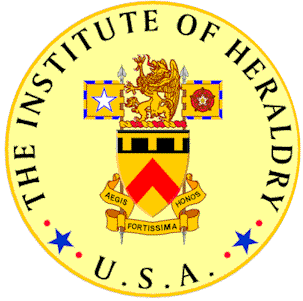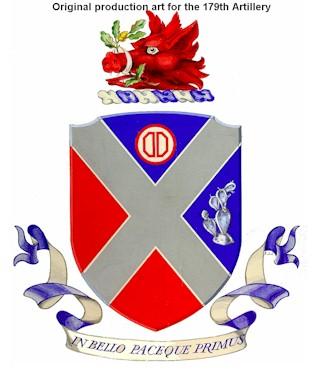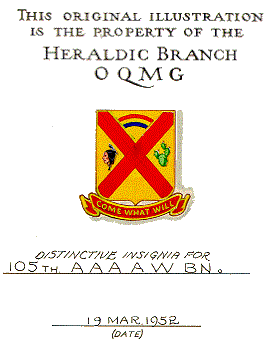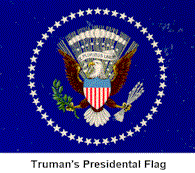
Heraldic Activity Established
Military heraldic symbols have been used in the U.S. military since the American Revolution. But it was not until 1919 that the heraldry activity was established as a separate function within the Army General Staff. This was in response to a 17 June 1918 letter to Secretary of War Newton D. Baker from President Woodrow Wilson requesting a higher quality of design and workmanship in new military medals. Colonel Robert E. Wyllie, Chief of the equipment branch of the General Staff was made responsible for military heraldry. He established the general rules and regulations that governed design of heraldic items. In his own words he, “…handled all matters connected with the design, approval, distribution, etc., of equipment on the General Staff level. During the war (World War I) we supervised the design of the Victory medal, the Victory button, the Distinguished Service Cross, the Air Corps insignia…” The General Staff requested that Quartermaster Corps personnel prepare paintings and manufacturing drawings of heraldic and other symbolic designs.
Coat of Arms

In 1920 the Army officially adopted heraldic coats of arms (see coat of arms for the 179th Field Artillery at right). This originated the use of distinctive unit insignia (more commonly called unit crests) to identify an individual soldier with his regiment. The purpose was to foster Army tradition and esprit de corps. The first unit to wear such an insignia was the 51st Artillery, Coast Artillery Corps which received approval for wear from the War Department on 18 March 1922.
QM Corps Assumes Responsibility
By 1924, heraldic responsibility was delegated to the Quartermaster General. The Heraldic Section of the Office of the Quartermaster General was responsible for the research, design and development of distinctive unit insignia, shoulder sleeve insignia (patches), flags, medals, seals, coats of arms and other heraldic items for the Army.

The Heraldic Section painstakingly performed historical research of unit histories to determine design and redesign of coats of arms and distinctive unit insignia. It was also responsible for ensuring quality control of the manufacture of the insignia that it had designed. The Heraldic Section assisted the manufacturer in meeting its stringent specifications by inspecting all models and dies and requiring samples of completed work. Before final acceptance, the design and prototype were approved by the Quartermaster General.
World War II
Under the direction of its chief, Mr. Arthur E. Du Bois, the Heraldic Section created hundreds of new insignia and several medals to meet the requirements of a quickly expanding of the Army in World War II. Du Bois simply stated the reason for military insignia in a 1943 National Geographic article, “These devices are sources of pride in oneself and in one’s organization. From this pride springs discipline; not discipline born of necessity and fear, but that which essentially is self-discipline, the essence of respect for self, for service, for country.”
Post World War Two
In 1949, the Munitions Board, acting for the Army, Navy and Air Force, directed that the Army provide heraldic services to all military departments. The program was expanded further as a result of Public Law 85-263, approved September 1957, 71 Stat. 89, which directed the Secretary of the Army to furnish heraldic services to the military departments and other branches of the federal government.
Staffing of the Heraldic Section and later the Institute of Heraldry, was (and still is) almost exclusively civilian with many staff members spending a lifetime with the organization. One example is Elizabeth Will who was employed for 43 years. She designed the Purple Heart, Distinguished Flying Cross and many other decorations, badges and insignia. Another is Elsie Meskill who served for 26 years. She prepared an illuminated testimonial presented by President Roosevelt to the Soviet leader Stalin during World War II. It had to be letter perfect, and when she was all but one letter from completing it, someone bumped her table. She had to start over, and a plane had to wait to carry the document overseas.
Institute of Heraldry is Born

On 10 August 1960, Army General Order Number 29 established the U.S. Army Institute of Heraldry under the control of the Quartermaster General. The Institute of Heraldry became the only organization within the government devoted to the science and art of military heraldry and other official symbolism. It provided heraldic services to the Department of Defense and other government agencies.
Accomplishments
The Institute redesigned and standardized the Flag and Seal of the President during the administration of President Truman (Executive Order 9646, 25 October 1945). The additions of the 49th and 50th stars to the Flag of the United States were handled by the Institute. The publicity connected with redesign of the U.S. Flag led to increased inquires by other government agencies for heraldic designs. President Kennedy established the Presidential Medal of Freedom in 1963 and directed through Executive Order 11085 that the Institute design it. Among the Institute’s numerous designs over the years are the Air Force Medal of Honor, Coast Guard Distinguished Service Medal, Seal of the Federal Aviation Agency and flag design for American Samoa.
Organizational Changes
The Army Adjutant General’s office assumed responsibility of the Institute in 1962 when the office of the Quartermaster General ceased to exist due to Army reorganization. In 1987 another realignment action put the Institute under the U.S. Total Army Personnel Command. In April 1994 the Institute of Heraldry moved from Cameron Station to Fort Belvoir, Virginia. As a result of a realignment in October 2004, responsibility for the Heraldic Program was assigned to The Administrative Assistant to the Secretary of the Army, Resources and Programs Agency. The Institute of Heraldry maintains a website where you can learn more about its current mission.
The U.S. Army Quartermaster Museum at Fort Lee, Virginia has in its collection many examples of the work of the Quartermaster Heraldic Section and the Institute of Heraldry. It has on display the first 50 star flag, one of the largest collections of presidential flags and an extensive collection of chevrons, patches, unit crests and medals.
Compiled from information in the Archives of the U.S. Army Quartermaster Museum, Fort Lee, Virginia and the U.S. Army Institute of Heraldry, Fort Belvoir, Virginia by K. Born, Museum Volunteer. Last Update: Sunday July 26, 2009
